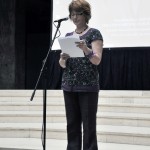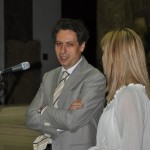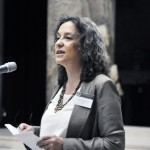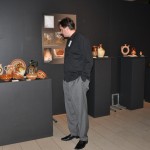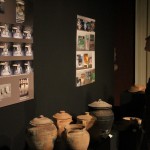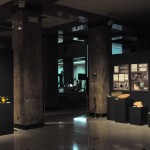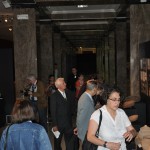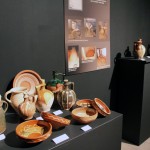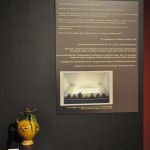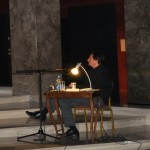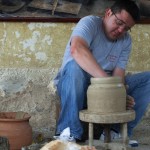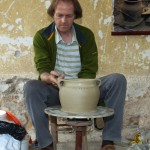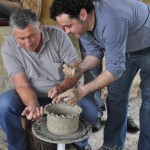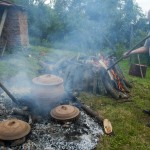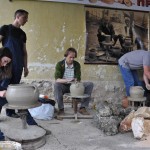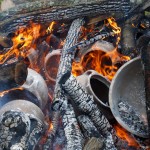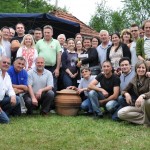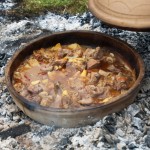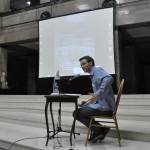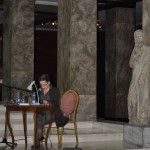TRADITIONAL POTTERY MAKING
FROM THE ETHNOARCHAEOLOGICAL POINT OF VIEW.
Scientific Research and Safeguarding of Intangible Heritage
June 10th – 12th 2011
National Museum in Belgrade (Serbia)
Friday, 10th June 2011
Opening of the Conference and the exhibition
Tatjana Cvjetićanin, director of the National Museum in Belgrade
Antonio Lázaro Gozalo, director of the Cervants Institute in Belgrade
Biljana Djordjević, coordinator of the Conference and the autor of the Exhibiton
Exhibition Three Facets of Traditional Pottery Making in Serbia
Three facets of traditional pottery making in Serbia_exhibition catalogue (pdf)
Moderator: Aleksandar PALAVESTRA 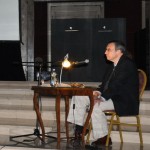
***
Marko Porčić, Faculty of Philosophy, University of Belgrade
RELEVANCE OF POTTERY ETHNOARCHAEOLOGY FOR THE STUDY OF LATE NEOLITHIC HOUSEHOLDS IN CENTRAL BALKANS
Abstract: The mainstream archaeology in Serbia has largely remained unaffected by major developments in archaeological method and theory. As a consequence, many research problems have not even been recognized. The insights of pottery ethnoarchaeology developed within the framework of processual and behavioral archaeology have only recently begun to be used in the context of Late Neolithic research. The aim of this presentation is to demonstrate the relevance of pottery ethnoarchaeology for the prehistoric archaeology of the Central Balkans. The first example shows how ethnoarchaeological knowledge can contribute to the social archaeology of Late Neolithic households. The second example shows that ethnoarchaeologically derived knowledge is necessary for framing and solving problems related to formation processes of the archaeological record.
Presentation (pdf):
***
Jasna Vuković, Faculty of Philosophy, University of Belgrade
POTTERY ETHNOARCHAEOLOGY AND ARCHAEOLOGY OF NEOLITHIC
Abstract: Pottery fragments are the most numerous finds on Neolithic sites throughout the Central Balkans. Chronological systems in the Neolithic archaeology were based upon ceramic forms and ornamental techniques. Unfortunately, many other aspects of pottery were neglected. Pottery ethnoarchaeology, along with experimental and interdisciplinary research, must become the main source of information about certain aspects of production and use of ceramic vessels, as well as in reconstruction of social organization, labor division and labor investment in ceramic production, vessel use-life, breakage and discard patterns, among others. Methodology of use-wear trace identification and their distribution on the Early Neolithic pottery from the site of Blagotin was established according to the results of ethnoarchaeological research among traditional communities: abrasion, carbon deposition and surface attrition. Ethnoarchaeological evidence was also the main source of information in research of technological aspects of pottery production, i.e. forming techniques and firing procedures, as well as emergence of standardization and craft specialization on the Late Neolithic pottery from Vinča.
Presentation (pdf)
***
Vesna Svoboda,1Mila Popović-Živančević,1 Radmila Jančić-Heinemann,2 Dragan Milovanović,3 Aleksandar Petrović,4 Suzana Polić – Radovanović,1 Julka Kuzmanović-Cvetković5
1Central Institute for Conservation, Belgrade/ 2Faculty of Technology and Metallurgy, Belgrade/ 3Faculty of Mining and Geology, Belgrade / 4Faculty of Philology and Arts, Kragujevac/ 5 National Museum of Toplica, Prokuplje
EXPERIMENTAL ARCHAEOLOGY – MULTIDISCIPLINARY RESEARCH ON THE PLOČNIK SITE
Abstract: Multidisciplinary research of traditional pottery production includes three primary areas: heritology, materials technology and experimental archeology, which are methodologically supported by geological and physical-chemical analysis, and methodological apparatus of anthropology and ethnology. Definition of intangible heritage in the field of traditional ceramics manufacturing, in accordance with the Convention on the Protection of Intangible Cultural Heritage (UNESCO), refers to the identification, investigation and documentation of authentic production technology of ceramics, and revitalization of intangible cultural heritage through education and the transfer of traditional techniques. In this paper the planned research phases of the Neolithic pottery Vinča (B), Vinča-Tordoš II, from the location near Prokuplje are presented. The main aim of this research is to protect the traditional production of pottery technology as an intangible cultural asset.
***
Nikos Efstratiou, Department of Archaeology, University of Thessaloniki
CERAMIC ETHNOARCHAEOLOGICAL RESEARCH IN THE BALKANS: THE CASE OF THE RHODOPE MOUNTAINS
Abstract: The ceramic ethnoarchaeological research carried out in the Rhodope Mountains, Greece, in the 1980s had the characteristics of a case-study which tried to address topics of pottery production, manufacture technology and distribution among the upland Pomak communities of the area.
It was the last chance to record and study the remains of a disappearing tradition of household pottery making in the Balkans, in the times of fast economic and cultural changes which swept away any material evidence of former ceramic systems in the region. Ceramic objects and different stages of their manufacture by members of local communities were recorded in interviews and by tape or video and therefore salvaged.
Moreover, ethnographic observations in a number of villages of the region were used to comment on particular questions both theoretical and methodological considered by archaeologists in their interpretation of archaeological ceramics. Topics like vessel function, raw material selection and preparation, division of labor, distribution, stylistic change, recycling and disposal, were discussed in the ethnoarchaeological research.
Presentation (pdf):
N. Efstratiou_CERAMIC ETHNOARCHAEOLOGICAL RESEARCH IN THE BALKANS THE CASE OF THE RHODOPE MOUNTAINS
Film „Techniques feminines de la poterie“, Nikos Efstratiou
***
Biljana Djordjević,1 Dragoljub Zlatković2
1National Museum in Belgrade / 2Pirot
TRADITIONAL TECHNOLOGY AND ITS VARIATIONS APPLIED IN MAKING BREAD-BAKING PANS IN THE STARA PLANINA MT. (SERBIA)
Abstract: It was already at the beginning of the last century that the first ethnographic researches of a most archaic method applied in making ceramic vessels – making of bread-baking pans without potter’s wheel – were begun. In the beginning of the 1950s the substantial body of this knowledge was put together in the comprehensive study of Milenko Filipović Primitive Ceramics made by Women among the Balkan Peoples. Nonetheless, the technological process of the so called “treading of bread-baking pans” still remains largely unknown primarily due to the lack of illustrative material so important in this case. The fact that this activity is part of women’s duties in rural households in mainly roadless areas indicates its possible antiquity which makes it most interesting for ethnoarchaeology, a scientific discipline being developed in Serbia only recently. Ethnoarchaeological researches carried out in the Stara Planina area in the past three years provided information about local variations in bread-baking pans making. The importance of diversity of technological procedures is discussed in this paper.
Presentation (pdf):
***
Dragoljub Zlatković, Pirot
MYTHOLOGY AND RITUALS IN MAKING BREAD-BAKING PANS ON STARA PLANINA MT. (SERBIA)
Abstract: Making of bread-baking pans in the Stara Planina region belongs both to domestic industry and to traditional practices. It offers a most interesting insight into the life of people half a century ago when this activity came out of practice. In isolated villages, the magic and the practical merged during centuries and turned into practice without significantly being changed through history. The paper illustrates the most typical examples of the magic and of the traditional in the entire area of the western part of Stara Planina Mt. which is part of Republic of Serbia and where I conducted researches from June 2003 to March 2011. This ancient traditional activity repeatedly taken in every household includes ancient magic and customary practices related to the magic of numbers, the magic of words, the magic of obscene behaviour, as well as to the transferring of the effects of favourable timing and favourable manufacture location into the bread-baking pan – the breadwinner.
Presentation (pdf):
D. Zlatkovic_ MYTHOLOGY AND RITUALS IN MAKING BREAD-BAKING PANS ON STARA PLANINA MT. (SERBIA)
***
***
Lebiba Džeko, National Museum BiH, Sarajevo
POTTERY IN LIJEŠEVO (BOSNIA AND HERZEGOVINA) – A LIVING TRADITION
Abstract: The significance and relevance the pottery in Bosnia and Herzegovina make it one of the most important countryside crafts. The pottery products were indispensable in every household and were part of everyday countryside life. Locations which are especially known for developed pottery craft are placed in the central part of Bosnia. A village where people are still engaged in pottery making is called Liješevo, located near Visoko. The key characteristics of these products as with most pottery craft made in Bosnia and Herzegovina are that they are all made on hand-turned pottery wheels. The main production tools are the pottery wheel and different kinds of wooden knives. Variety and design of products have not changed much over the years. Present-day pottery is made for decorative purposes mostly and is not meant for every day use. Pots, bardaci (bottles for carrying water), surahije (bottles for storing water) are the most common products and can be bought at roadside stands and fairs. There are only three people in Liješevo village who presently engage in pottery craft, though only as a hobby. Interest of young people in learning pottery craft does not exist.
***
Vladimir Djukanović, Museum of Republic of Srpska
PEKVA – LARGE HAND-WHEELED POTTERY LID FOR COVERING BREAD DURING BAKING
Abstract: The pottery collection of the Museum of Republic of Srpska has 119 three-dimensional items. The most significant period in collecting of these items was from 1947 to 1951. During this period, the museum curators have performed field research on the territory of Bosanska Krajina. Pottery craft represents processing, modeling and making of various useful items of clay. The main product of this craft is a pot, and all craft was named after it. This craft has developed in areas where the clay was in sufficient quantity and good quality. Some of the centers of this craft in Republic of Srpska were Ivanjska, Dvorani, Miloševići and Žabari near Banja Luka and Mrkonjić Grad. But in the second half of the 20th century the pottery craft comes to extinction. Besides the pot, a very important product of the potter’s craft is pekva (clay lid for baking), up to the mid 20th century, almost every rural household had this product. And as the process of making pot has presented in the literature, in this occasion we will present the process of making pekva. The process of making pekva carried out in thirteen stages.
Presentation (pdf):
V. Djukanovic_PEKVA – LARGE HAND-WHEELED POTTERY LID FOR COVERING BREAD DURING BAKING
***
Mirjana Randić, Ethnographic Museum, Zagreb
ROLE AND POSITION OF TRADITIONAL POTTERY PRODUCTION IN CROATIA
Abstract: For the past hundred years, ethnographic researches into traditional pottery in Croatia documented potters’ work, also focussing on relevant historical data, which could help discern the process of pottery-making during the last several centuries. Museum exhibits are often the only remnants of once productive pottery centres. Skill of producing hand-wheel pottery, vivid some decades ago in Potravlje, Iž, Rakalj, Kaluđerovac, is nowadays represented by just a few remaining potters. Kick-wheel pottery makers, that still work in several villages in Hrvatsko zagorje (Jerovec, Bedenec, Dubravec, Globočec), are aware that traditional skills are losing battle with modern production of kitchen vessels, so they switched to souvenir and decorative objects. In the same time, ethnologists try to preserve intangible cultural heritage and enable masters of ancient skills use their knowledge at the best and pass it to new generations. Efforts have recently been made in Croatia to preserve traditional skills, especially concerning lace-making (Pag), regional food (Poljica), and blacksmith’s, potter’s, cart-wright’s and weaver’s craft of Hrvatsko zagorje. These efforts should help potters and other craftsmen in Croatia to evaluate their position in front of different administrative obstacles which they must cross in order to profit from their skills in acceptable way.
Presentation (pdf):
M. Randic_ROLE AND POSITION OF TRADITIONAL POTTERY PRODUCTION IN CROATIA
Film „Hand-wheel potters in the Western Balkans“, Richard Carlton (pdf)
***
Suzana Antić, National Museum – Zaječar
POTTERY MAKING IN ZAJEČAR
Abstract: Several scientific disciplines approach the study of pottery from their respective angles. Ethnology pays particular attention to the craft itself, among other things – from every step in pottery processing, developing of handicraft pottery skills into craft, to the ways of marketing the products as well as to disappearance of the pottery ware that is, the interweaving of traditional pottery and contemporary ceramic art. Both the literature and direct interviewing of the two remaining potters from Zaječar provided valuable information which has been included in the text which is a synthesis of the cabinet and field work on this material.
***
Juan Jesús Padilla Fernández, University Complutense, Madrid
SEDIMENTATION OF CLAY IN LAS COGOTAS POTTERY (CARDEÑOSA, ÁVILA, SPAIN): AN ETHNOARCHAEOLOGICAL APPROACH
Abstract: Between 1986 and 1990, archaeological investigations have been carried out in the second sector in the Castro of Las Cogotas (Cardeñosa, Ávila). Thanks to the excavation works done, the unique pottery center of the Vetton world has been documented. Avoiding interpretation of pottery products only as objects and convinced that social values of a specific community should be appreciated not only by the final pottery product, but also in every phase involved in the production process, I have carried out a detailed ethnoarchaeological study of all stages of the manual process involved in Las Cogotas pottery, from obtaining the raw material to the final product creation. The investigation required activities related to experimental archaeology, allowing to research, to the greatest possible extent, the complex process of pottery manufacture characteristic of those societies. The production of the humbo, a particular pottery decoration connected to the Celtiberian tradition, can be considered as good example; thanks to these studies we were able to interpret possible mode of manufacture. A correct ethnoarchaeological and experimental approach to the pottery production process of the Vetton world, has allowed the creation of an interesting way of study which has permitted us to get the insight into possible uses (economic, social and imaginary) and the distribution of those cultural material elements, results as well of the production process.
***
Andreja Kudelić, Institute of Archaeology in Zagreb
THE REMAINS OF POTTERY KILN AND (OR) A REFLECTION OF SPIRITUAL EXPRESSION OF BRONZE AGE POTTER
Abstract: The subject of my work is an interesting find from Bronze Age settlement Velika Gorica – south, situated a few kilometres south of Zagreb. It is a shallow pit object shaped as digit eight. The south side is filled with a lot of arranged fragments of ceramic vessels, while the north side is filled with just a few vessel fragments. Pits are divided with a clay barrier in the middle. On the bottom of the pit, in the central part, there is a circular cut, diameter 40 cm, depth 43 cm. The shape of the pit suggests that it is some kind of kiln, but an important element is missing to support this theory. There is no visible fire activity on the walls. Still, I have experimented and tried to reconstruct a possible kiln and demonstrate how it could have functioned. On the other hand, Bronze Age settlements throughout Central Europe (and beyond) as part of their spiritual expression kept so called ceramic depots. At first, interpretations were based on poor documentation and just a few explored units, and they were often connected to potters and pottery workshops (potter’s supplies, potter’s waste etc.). With time, these interpretations were abandoned, and the emphasis was put on libation rituals, sacrifices, sacrificial meals, etc. The ideas I bring to you through this work are only preliminary thoughts about the mere function of the finding…whether it is a pottery workshop/kiln or a ceramic depot.
Presentation (pdf):
***
Lourdes Girón,1 María da Conceiçao,2 Juan Pablo Martínez,3 María Lazarich1
1University of Cadiz / 2University of Coimbra / 3University of Granada
ANTE COCTURAM MARKS ON THE ROMAN POTTERY: TRADITIONAL CRAFT PERCEPTION
Abstract: To find out more about the procedure applied in manufacturing ante cocturam marks on Roman pottery we present this work which tries to understand the methodological processes of this action. In this sense, we aim to recreate the execution of marks on pottery availing ourselves of experimental archeology. Through the comparison of marks on Roman pottery, the purpose of this research will be to establish how they were produced and so we will learn more about the domestic pottery production processes and about tools that they used for these works.
Presentation (pdf):
***
Spomenka Vlahović, Varaždinske Toplice
THE CONSTRUCTION OF ROMAN CERAMIC KILN REPLICA FOR ROMAN CERAMICS REVITALIZATION ON THE AQUAE IASAE ARHEOLOGICAL SITE AT VARAŽDINSKE TOPLICE
Abstract: The lecture presents a brief review of the project for constructing a Roman ceramics kiln replica that had been constructed on the Varaždinske Toplice archeological site during May, 2009 on the occasion of the Internantional Museum Day. The kiln replica was built from natural materials, under the guidance of Bernd Pfannkuche, the German university lecturer, publisher ad professor, who is one of the leading experts on issues connected with constructing such kilns, member of the International Academy of Ceramics (AIC) in Geneva, and an artist who practices in the area of the so called arhichitectural ceramics.
***
Bosa Rosić, Zlatibor
POTTERY PRODUCTION OF IN THE WORKSHOPS OF UVAC MONASTERY (SERBIA), 15th – 17thCENTURY
Abstract: Uvac monastery is situated in western part of Serbia on the river with the same name also the largest tributary of the river Lim. It belongs to the large corpus of 75 Lim area monasteries, the greatest part of which is still in ruins and which used to be in the central area of the Raška state. A multidisciplinary research with a complete reconstruction of this monastery was finished in the period from 1994 to 1998. Based on this research it has been concluded that this monastery, in the period of its existence, (from the fifteenth to the end of seventeenth centuries) represented such an economic community which enabled an independent life not only for its monks. With the products manufactured in its own workshops it also satisfied needs of the local population thus being independent of the neighbouring city centres. At that time, as it is known, cities were populated exclusively with Turks who held authority, crafts and trade in their hands. Serbian population stayed away from the cities in order to avoid the ruling Turkish class. In the Uvac monastery, apart from the blacksmith’s workshop with the two forging furnaces, a big workshop for manufacturing earthen dishes was found. In this workshop, located in the northern part of the complex, the remnants of waterworks were found, as well as a big pit for mixing clay, and furnace remains where dishes were baked. Also many parts of the dishes as well as whole dishes, (big and small pots, and various dishes for baking) manufactured in this workshop were found. In the vicinity of the monastery findings of clay as well as of magnesite and quartzite were found, which were mixed with clay. In the paper, the found earthen products will be presented and, within the knowledge so far, the technology of their manufacture.
Presentation (pdf):
B. Rosic_POTTERY PRODUCTION OF IN THE WORKSHOPS OF UVAC MONASTERY (SERBIA), 15th – 17th CENTURY
***
Saturday, 11th June 2011
Excursion to Zlakusa (visit to a potter’s work shop, demonstration of hand-turned wheel modelling, bonfire – traditional method of pot firing, showroom exhibition and traditional Zlakusa lunch)
Sunday, 12th June 2011
***
Juan Pablo Martínez Muñoz, Alfareria Tito, Úbeda (Jaén), University of Granada
SPANISH POPULAR POTTERY: AN APPROACH FROM THE SECOND HALF OF THE 20th CENTURY TO PRESENT
Abstract: Our aim with this basic approach to Spanish pottery in the last 60 years focuses on several key topics: a general overview of the technical and aesthetical features in a variety of workshops existing nowadays, recently disappeared or in the process of disappearing; analyzing the common and differentiating features among the different workshops, as well as their interactions; influence of the environment in the manufacturing of pottery. We will also study the strategies adopted in order to survive to the deep socio-cultural changes occurred in the aforementioned period. The answers proposed to new challenges, such as tourism, new materials, global market, etc. We will also highlight the struggle produced between tradition and the need for survival. La ponencia mantendrá un hilo conductor desde una perspectiva de género, destacando la enorme importancia de la mujer en la historia de la alfarería y las diferentes exclusiones padecidas en las distintas épocas. The paper will be structured from a gender sensitive approach, reflecting the key importance women have had in the history of pottery, as well as the oblivion they have lived in along the centuries. Our final aim is to vindicate the poetic and expressive possibilities of pottery, a defense of its aesthetic and functional importance four humanity in the past, present and future.
Presentation (pdf):
***
Jaume García Rosselló, University of Balearic Islands, Palma de Mallorca
POTTERY MANUFACTURING PROCESS IN KRUMIRIA (TUNISIA): OPERATIONAL CHAIN AND MANUFACTURING MARKS
Abstract: This paper proposes an interpretative approach to the problem of ceramic technology. This proposal aims to improve the methodology for identifying manufacturing marks on hand-modelled archaeological ceramics. One of the main problems in archaeology is that usually there is no factual knowledge about actions of individuals. By contrast, etnoarchaeology allows us to compare the actions of individuals with the products they generate. Therefore, we argue ethnoarchaeology is the appropriate discipline when the manufacture of identifying marks and understanding of the formation processes are concerned. We propose an analytical method for study modelling marks based on creating reference collections obtained from the study of present potters groups. Our work has focused on the study of potters and their products in the Krumiria and Sahel of Tunisia. These two production centres produce and use techniques which differ slightly. The identification of macro manufacturing traces can help us to understand technical procedures that were generated by them. These procedures should be classified and organized into sequences. Therefore, the operational chain concept is essential for organizing such actions and comparing the modelling systems. Our goal is to improve the identification methodology of material evidence in manufacturing and to compare the feasibility and potential of the classification system of technological procedures. Also, we need to be aware that the documentation of current ceramic manufacturing techniques is a cultural emergency as they are disappearing very quickly.
***
Gordan Nikolov, National Museum of Macedonia, Skopje
CONSTRUCTIVE, RECONSTRUCTIVE ETHNOLOGY – OPPORTUNITY FOR A DYNAMIC UNDERSTANDING OF FOLK POTTERY – MACEDONIAN CASE
Abstract: Ethno-archaeological research related to pottery is an important link in understanding and preservation of the processes or the technologies of creating objects from clay, starting from the very beginning, from choosing the proper type of clay, its digging from the ground, methods of clay preparation, decorating, baking, up to the utilitarian, ritual, оr some other function objects may have had. The study of folk pottery in the world, especially in the Balkans must be perceived as a regional challenge that can be realized through regional projects only. There were only about twenty of serious investigations pertaining to folk pottery in Macedonia from 1945 until today. In my research I undertake reconstructions of processes used in making the objects. The first reconstruction was started ten years ago when I put together data from literature and data from the field research whilst reconstructing the process of the preparation of the bread baking pans from the village Kučevište. After years-long survey of the pottery in the village Vraneštica – Kičevo, the method of reconstruction/construction was regularly applied because I lived and worked with potters thus erasing the borderline between outsider/insider position. As active participant in the research I completely changed my understanding of the processes of pottery manufacture and consequently their recording and interpretation. Making scale models of traditional pottery wheels and kilns along with potters is one of the ways through which we can better understand the technology of creating objects which are the aim of our research. My opinion is that the colleagues who work with ceramics exhibits must possess basic knowledge of the processes applied in preparation of pottery so that they can properly act.
Presentation (pdf):
***
Richard Carlton, School of Historical Studies, University of Newcastle upon Tyne
THE STATUS AND POTENTIAL OF TRADITIONAL POTTERY-MAKING IN BOSNIA-HERZEGOVINA
The recorded modern pottery-making traditions of the western Balkans are amongst the most diverse in Europe, having developed by various cultural processes into a proliferation of traditions fully reflective of the long and complex history, not to mention present range of ethnic, national and other identities in the region. Pottery-making in Bosnia-Herzegovina reflects the diversity of the wider region, although the almost-universal use of the hand-wheel has tended to obscure the variations apparent in other aspects of production. The present paper will discuss the historical diversity of pottery-making in the country, focusing on potters currently or recently active, including those at Malesici, Ularica, Pulac, Lijesevo, Visnjica & Skokovi, including the potential for further ethnographic study and continuity of tradition. Finally, a number of significant findings of archaeological relevance derived from a combination of historical studies and more recent fieldwork will be summarised. Notably, comment will be made on how cultural distinctiveness is reflected by pottery; a great deal is made of supposed cultural differences between different identity groups in Bosnia; but beneath the differences highlighted in times of conflict is a deeper common heritage well exemplified by traditions of pottery-making and use.
***
Richard Carlton, School of Historical Studies, University of Newcastle upon Tyne
CERAMIC ETHNOARCHAEOLOGY IN THE WESTERN BALKANS
This paper will focus on the results, questions and perceived opportunities suggested by the author’s long-term study of pottery-making in the Western Balkans. Particularly it will attempt to address the potential of ethnoarchaeological research as a research tool in archaeological interpretation, and the extent to which it has been applied. Distinction will be drawn between European/’Old World’ and North American approaches in this regard, and problems of incorporating ethnographic knowledge from the perspective of professional archaeology will be elucidated. How do we make decisions about what is important to know and to preserve, and is it enough to preserve only by record? Some examples will be presented of findings derived from ethnoarchaeological research in the region which have the potential to change archaeological assumptions, and some approaches for particular case studies combining archaeological and ethnographic data are also suggested.
Presentation (pdf):
R. Carlton_CERAMIC ETHNOARCHAEOLOGY IN THE WESTERN BALKANS
***
Ljiljana Gavrilović, Institute of Ethnography SASA, Belgrade
ETHNOARCHAEOLOGY: A HISTORY OF ORDINARY PEOPLE’ CULTURE
Abstract: This paper discusses ways in which ethnoarchaeology discourse changes a traditional concept of culture development and/or civilization, providing data in contradiction with the classical perspective of cultural progress, based exclusively on material remains of the elite cultures. Both ethnography and archeology data show that for centuries, culture changes were, for the majority of people, only minimal. A house dating to the Vinča cultural period was for instance almost identical to rural houses from 19th or beginning of 20th centuries. Agriculture, and processed food also had not changed considerably until the second part of 19th century, while in areas with belated technological development, it had lasted long into the 20th century. The example of pottery technology will show ways in which ethnoarcheology can enhance our understanding about cultural changes, allowing at the same tame time not only new data in both disciplines but also a much clearer insight into cultural processes during a very long time period.
***
Aleksandar Palavestra, Faculty of Philosophy, University of Belgrade
IN SERVICE OF CONTINUITY. ETHNO-ARCHAEOLOGY IN SERBIA
Abstract: Ethnoarchaeology, as the discipline of archeology, is the study of the various aspects of present day lifestyles, which allow archaeologists to understand the dynamic processes in past that created archaeological evidence and archaeological record. Ethnoarchaeology in Serbia did not have a good fate, since almost all paths that could lead to ethnoarchaeology, were clogged with different conceptions of the idea of continuity. In Serbian archeology the continuity was understood as a sequel of the direct Aegean and Greek influence, as a metaphysical continuity of the spirit, as an unexplained “ideal-type” continuity, as national continuity, or as transmission of cultural traditions. Common to all these different paradigms is that continuity was considered as something that implies and that is self-evident. Therefore, the ethnographic material was used only as an illustration of the long duration of particular cultural forms. The real value of ethnoarchaeology, as of the method that can overcome the static archaeological record and establish insight into the dynamics of the past, was not recognized.
Presentation (pdf):
A. Palavestra_IN SERVICE OF CONTINUITY. ETHNO-ARCHAEOLOGY IN SERBIA
***
Tatjana Cvjetićanin, National Museum in Belgrade
MAKING HISTORIES FROM MAKING POTTERY. USING ETHNO-ARCHAEOLOGICAL APPROACH TO PRESENT POTTERY IN MUSEUMS
Abstract: Archaeology contributes to making different histories and those histories are changing, reflecting the shift in emphasis of current archaeological paradigms. Ethno-archaeological researches are valuable resource for opening new ways of interpreting archaeological material culture in museums, for making archaeological narratives more meaningful and relevant to people today. What stories and what type of history could be written in a museum on traditional pottery making and how those histories should use knowledge gathered through ethno-archaeology is discussed.
Presentation (pdf):
***

